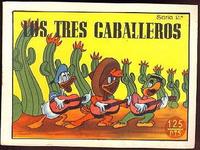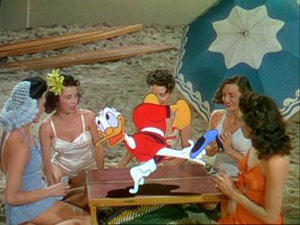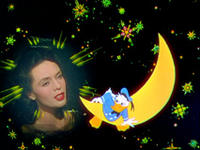The Three Caballeros
 I commented recently on how Latin America functions as the West's unconscious. Disney's The Three Caballeros is an extraordinary demonstration of this point.
I commented recently on how Latin America functions as the West's unconscious. Disney's The Three Caballeros is an extraordinary demonstration of this point.The first half of the movie is a more or less conventional series of sequences. Donald Duck receives birthday presents from his Latin American friends that include a film projector and a reel of film, plus a book about Brazil. Donald sets up the projector then guides our viewing responses as we watch with him the tale of a mal-adapted penguin from the South Pole who looks for warmer climes further north. We are also introduced to an array of other Latin American birdlife, and are told the story of a Uruguayan flying donkey. So far, so Disney.
Things start to get a little stranger with the introduction of Joe Carioca, a Brazilian parrot who had made his first appearance in Saludos Amigos. Carioca takes us through the Brazilian book, shrinking Donald in Alice in Wonderland style so that he can literally enter into its pages. But these pages offer more, not less, of a sensation of reality than Donald's cartoon universe: within them, latinidad is fleshed out by means of a novel intermixture of animation and live action, featuring Carmen Miranda's sister, Aurora.
This proximity to Latin sexuality incarnate starts to turn Donald's head. And when Aurora kisses him, crossing the divide between cartoon and "real" life, his mind starts to explode in a series of images anticipating sixties psychedelia: lights, multicoloured balloons, frenzied dancing, spirals, lightning...
By the time that he and Joe meet the third of "the three gay caballeros," a Mexican rooster named Panchito, Donald has become an almost purely libidinal subject, keen to cavort, in what Jean Franco terms "a kind of erotic fury" (The Decline and Fall of the Lettered City 27), with bathing beauties on the beach at Acapulco.

"You are a wolf," Carioca tells him. "Take it easy." But Donald has begun to surrender to his id. And the final ten minutes comprise a bizarre insight into his psyche, as any pretence to narrative almost entirely disappears. Franco quotes the New Yorker review: "a sequence involving the duck, the young lady, and a long alley of animated cactus plants would probably be considered suggestive in a less innocent medium" (qtd. 27).
 There are girls, flowers, nightmarish interruptions, transvestism, floating body parts. At one point we see Donald's head in the middle of the screen, superimposed onto a pink flower, while around him other flowers open to reveal images of women's faces looking on adoringly and a voiceover whispers "purty girls, purty girls, purty girls."
There are girls, flowers, nightmarish interruptions, transvestism, floating body parts. At one point we see Donald's head in the middle of the screen, superimposed onto a pink flower, while around him other flowers open to reveal images of women's faces looking on adoringly and a voiceover whispers "purty girls, purty girls, purty girls."Jean Franco again, worth quoting at length:
Disney was not so much bringing to life universal dream-fantasies as inventing them. The Three Caballeros was a celebration of the pleasure principle freed from ethical considerations and responsibility, and most important of all, abstracted from a context while the technical innovation underscored the industrial superiority of the United States. The Three Caballeros heralded things to come. But it also invites speculation on the very idea of "animation"--giving soul and life to an inanimate object, a drawing, or a sketch on a piece of paper. The animated cartoon vies with the real and forecasts the power of the simulacrum that today draws millions of Latin Americans to Disneyland and Disneyworld. (28)
